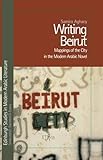Writing Beirut : Mappings of the City in the Modern Arabic Novel / Samira Aghacy.
Material type: TextSeries: Edinburgh Studies in Modern Arabic Literature : ESMALPublisher: Edinburgh : Edinburgh University Press, [2022]Copyright date: ©2015Description: 1 online resource (240 p.)Content type:
TextSeries: Edinburgh Studies in Modern Arabic Literature : ESMALPublisher: Edinburgh : Edinburgh University Press, [2022]Copyright date: ©2015Description: 1 online resource (240 p.)Content type: - 9780748696246
- 9780748696253
- 892.7/36/093256925 23
- PJ7577 .A378 2015
- PJ7577 .A379 2015eb
- online - DeGruyter
- Issued also in print.
| Item type | Current library | Call number | URL | Status | Notes | Barcode | |
|---|---|---|---|---|---|---|---|
 eBook
eBook
|
Biblioteca "Angelicum" Pont. Univ. S.Tommaso d'Aquino Nuvola online | online - DeGruyter (Browse shelf(Opens below)) | Online access | Not for loan (Accesso limitato) | Accesso per gli utenti autorizzati / Access for authorized users | (dgr)9780748696253 |
Frontmatter -- Contents -- Series Editor's Foreword -- Acknowledgments -- Note on Transliteration -- Introduction -- 1. The Rural-Urban Divide: Subverted Boundaries -- 2. The Rhetoric of Walking: Cartographic versus Nomadic Itineraries -- 3. Sexualizing the City: The Yoking of Flesh and Stone -- 4. Traffic between the Factual and the Imagined: Beirut Deferred -- 5. Excavating the City: Exterior and Interior Relics -- Inconclusive Conclusion -- Bibliography -- Index
restricted access online access with authorization star
http://purl.org/coar/access_right/c_16ec
Takes a geographical/spatial approach to Beirut seeking to understand how the city is imagined in fictionExploring the ways in which writers utilize the spaces of the city - joining the factual with the imaginary - this book shows how idiosyncratic perceptions of Beirut are produced, generating an infinite number of Beiruts. The city emerges as interactive, dynamic and historical, a place that is created from the streets, buildings, and monuments as well as through performance and social interaction. By referring to factual places in Beirut, the novels produce a strong reality effect through a mimetic mode of expression. Simultaneously, these texts reveal that Beirut is an unstable locale that resists fixity and transparency, shifting between the real and imagined, and the "idian and discursive.Writing Beirutexplores the city in 16 Arabic novels focusing on the urban/rural divide, the imagined and idealized city, the city through panoramic views and pedestrian acts, the city as sexualized and gendered, and the city as a palimpsest. While the book focuses on Beirut in Arabic novels, the introduction provides a thorough overview of Beirut in the modern Arabic novel.Key FeaturesTakes an innovative approach to Beirut focusing on the spatial and geographical in a close literary analysis of 16 modern Arabic novels from various parts of the Arab worldShows how Beirut is imagined in fiction and how writers use the spaces of the cityDraws on sources from the field of geography and space including Foucault, Lefebvre, de Certeau, Sja and Rose
Issued also in print.
Mode of access: Internet via World Wide Web.
In English.
Description based on online resource; title from PDF title page (publisher's Web site, viewed 02. Mrz 2022)


